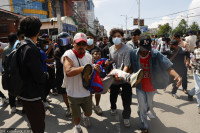Editorial
Make it count
The 2021 census presents us with an opportunity to right the wrongs.
The Central Bureau of Statistics is preparing to conduct the country’s most comprehensive census later this year in May and June. The last headcount conducted in 2011 was embroiled in controversies for under-representing people from different categories like religious minorities and caste groups. Early on, members of the Citizen Observation Committee were also certain that the information of the census would be inaccurate as they found the teachers, who had been hired as supervisors and enumerators, were not well trained in data collection besides other discrepancies at the census sites. The census report had also drawn flak from various quarters for data manipulation.
The 2021 census presents us with an opportunity to right the wrongs and mine a complete and updated socio-demographic data from across the newly enshrined federal structure by using updated research methodologies. Needless to stress the significance of a data-driven world, the new census will be an important and a massive undertaking because it will, for the first time, attempt to provide a clear demographic picture of the country, taking stock of not just households but also livestock, household amenities and local infrastructure.
Nepal has gone through sweeping changes since the last census which only covered 12 percent of the country’s households. However, the new census has an ambitious plan to collect microdata from all three-tiers of the government, which is essential for effective governance and autonomy. To do this, the bureau has come up with some 80 questions to accurately record minute details such as the differentiation between residential and commercial buildings or if a house was built through the government’s earthquake reconstruction fund.
The bureau intends to achieve this mammoth of a task by reaching out to every household to collect data directly. It estimates the entire process will cost Rs4.5 billion and plans to set up provincial census offices by mid-March and offices at the district and local levels. Bureau officials have also stressed that local residents and youths should be prioritised to lead the data collection process, and are set to hire and train a workforce of about 52,000 people—39,000 enumerators, 8,000 supervisors and 5,000 officials.
Garbage in, garbage out. Data collection is the most important stage where supervisors and enumerators have a major role to play. Any discrepancies in the census can affect research outcomes, which would defeat the purpose of conducting a national survey of this scale and budget. The bureau has to learn from the past, and ensure that its foot soldiers and their supervisors understand the process, and acquire the skill set required to execute their roles professionally and ethically. It must also actively monitor that research methodology is fully adhered to while conducting the census within a short time frame of two months.
An accurate count would arm the government, the private sector and other stakeholders with reliable data, which is essential to plan development policies and programmes and raise investments across provinces for another decade. It is crucial that the new census accurately counts because it would determine fair political representation and equitable access to national spending allocated for primary services to citizens. Therefore, the bureau bears immense responsibility to conduct the 12th census fairly and efficiently to ensure that data is collected and processed accurately.




 9.12°C Kathmandu
9.12°C Kathmandu














